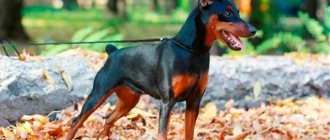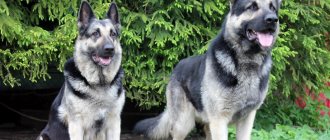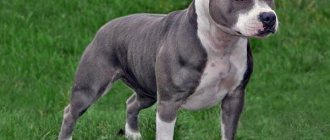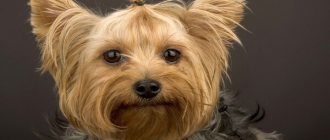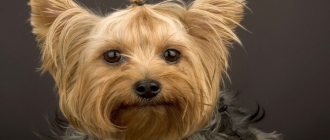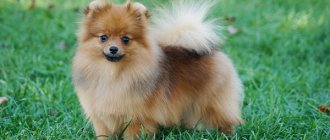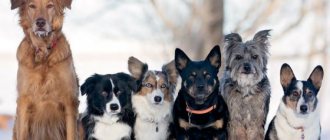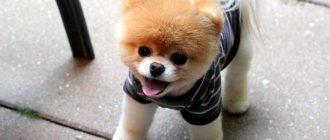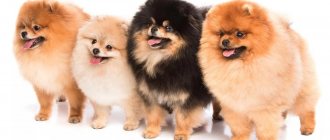Description
Being a selective breed, schnauzers of different sizes have common features. The only difference is the sizes. There are three of them: small, medium and large.
The Schnauzer is a strong-looking, square-shaped dog. The back is slightly inclined at the sacrum.
The head appears massive due to the specific structure of the hair around the jaws and on the eyebrows. The muzzle is blunt, the transition from the nose to the forehead is clearly defined. The jaws are grasping and strong.
The ears are small and triangular in shape. Due to the fact that they hang on cartilage, until recently it was customary to dock them, just like the tail, which is curved towards the back.
The neck is strong. It smoothly transitions into a toned body. The sternum is well developed. The front paws are standard.
The Schnauzer has pronounced limb angles. This makes it possible to jump with ease and quickly trot with a flourish.
An active, cheerful dog easily endures bad weather. Wool with hydrophobic properties does not become very dirty. The specificity of the Schnauzer in the structure of the hair coat. It requires plucking. The undercoat is dense and does not shed. You will have to brush it almost daily.
According to the standard, it is customary to divide the color into black and “pepper and salt”. Any large spots of white shades are a sign for disqualifying the representative and sending the schnauzer puppy for culling, except for miniature representatives. Among them, more and more white dogs are appearing.
Miniature Schnauzer and Miniature Schnauzer: comparison
Laika (dog): types, what it looks like, breed description
Of the three available varieties of schnauzer, the miniature or miniature schnauzer is most often chosen as pets, since the reader schnauzer is too large to live in a city apartment.
Different colors of miniature schnauzers
The difference between the miniature and the midget is small. These are mainly dimensions: the miniature looks more like a lap dog. The advantage of the miniature schnauzer is the larger selection of available colors, since white and the combination of silver and black are found only in this type of schnauzer.
Both species are similar in character, they are bred to the same standards, which means that breeders are aimed at preserving the same traits for both dogs. Schnauzers are all friendly and loyal. For reasons of impressive appearance, the Miniature Schnauzer wins over the Miniature Schnauzer, but only because of the size, to which the whole choice ultimately comes down.
Important! Do not forget that each dog is unique and may have its own traits, independent of breed.
Origin story
The Schnauzer breed is descended from the Pinscher, which was previously known in two varieties: smooth-haired and wire-haired. Due to breeding work to select the working qualities of the best representatives of the breed, a completely new type has appeared. The literal translation of the breed means “muzzle with a mustache” or “mustachioed muzzle.” In essence, this is a new pinscher with a hard coat and improved breed characteristics.
The county of Bavaria is considered its homeland. There they were especially valued and used as:
- hunters of small rodents that damage farmers' property;
- security guards who quickly responded to extraneous noises, closely monitored what was happening and caught troublemakers;
- cattle drovers.
The result is a universal dog capable of performing many tasks.
The identification of larger representatives in the breed made it possible to use their natural strength to transport goods.
The formation of standard characteristics of the breed began relatively late, compared to the appearance of the Bavarian dog. Known since the Late Middle Ages. The elegance of the new breed attracted artists and sculptors. The genes of terriers and griffins are found in the blood of schnauzers, which explains their behavior.
The breed received its final appearance by the mid-19th century. At the same time, two colors were established: gray and black. By crossing representatives of the breed with a poodle and a German Spitz, both color combinations and three varieties were distinguished: small, medium, large.
At the Hanover Exhibition in 1879, first place was taken by a wire-haired dog of the same name, the modern name of the Schnauzer breed. This was the beginning of mass dog breeding.
Two decades later, in the first decade of the last century, the first Schnauzer fan club was registered. A little later, the same thing was done in the USA and Great Britain.
The first schnauzers appeared in the USSR in the early 30s, but the Great Patriotic War prevented breeding. The revival took place in the mid-70s, when purebred dogs were brought from the GDR. A little later, genes from other countries of the former “socialist camp” joined the breed line: Hungary, Yugoslavia, Bulgaria. This made it possible to diversify the breed's characteristics and improve them, achieving offspring with good performance.
The breeds were finally formed in the first half of the 20th century. The dogs are recognized internationally.
Types of Schnauzers
There are three officially recognized breeds. The dictates of the times and long-term selection have brought forth an additional one, which has not yet been registered at the international level.
Schnauzer mix
As a result of an unplanned or irresponsible attitude towards mating. The most common combinations are miniature schnauzer and dachshund, giant schnauzer and shepherd, miniature schnauzer and medium poodle. To obtain a silkier coat, they tried to cross it with a spaniel, which resulted in a cocker schnauzer with long ears. There are many variations.
Considering that the Schnauzer was obtained by crossing different breeds of dogs, he himself can be considered a mestizo. It contains a mixture of many bloods, which became the basis of the standard after the most successful representatives were bred to meet the needs of breeders. Officially, many owners explain this behavior as an attempt to gain other character traits and behavior.
An attempt to inject new genes leads to dire consequences, despite the assurances of careless owners. As a result, the dog does not acquire the desired traits. She looks pretty on the outside. The character is excellent, but it still turns out to be a mongrel. The dog will not have the typical traits of any one breed. The only positive factor is the low price of the puppy. Often the dog is given away for free, understanding that there will be no prospects for breeding and there is no way to make a show career.
Miniature Schnauzer
The medium-sized breed is often referred to as the Schnauzer and is the classic member of the group. According to the standard, height should be no higher than 50 cm, while weight should not be more than 20 kg. The coat color is predominantly “salt and pepper” - grayish, closer to silvery shades. There are black breeds. According to the description of the breed, the body is square, the body is muscular and lean.
A lively temperament, characterized by increased activity, appeals to those who love sports, movement, and cannot imagine their life without walks in the fresh air. The medium-sized wire-haired schnauzer will be happy to keep company, to follow alongside, to run, to rush around, to catch up. Dogs have their own preferences in toys. A ball, a ring, a puller - something that you will definitely carry in your teeth on walks and have fun.
Despite all its activity, the dog remains an attentive guard. He will never lose sight of the owner and will monitor the child’s behavior. A good nanny for kids on walks and at home.
Ancient hunting instincts manifest themselves occasionally when a dog picks up a scent and begins to search for prey. At this moment she turns into a “search engine”. At the same time, it is unlikely to run far, unlike other breeds.
The Schnauzer likes to learn, show tricks, and follow commands. Representatives of the breed are used in agility and sports competitions. High trainability is one of the advantages of the Miniature Schnauzer. With proper upbringing, it is an ideal dog for a family.
Giant Schnauzer
The large schnauzer looks regal in appearance. The image is complemented by a special shape and size. At the withers, an adult dog reaches 70 cm and weighs about 35 kg. The difference between male and female is clearly visible. Girls have a less pronounced sternum and a more fragile physique.
The truly gigantic size of the dog was originally suitable for hunting large animals and was used as a wolfhound. At the beginning of the 20th century he was called the “Russian safecracker”. During wars and civil strife, the schnauzer transmitted messages and participated in transportation.
The leading qualities of the breed are devotion and mental balance. At rest the dog is almost unperturbed. He likes to lie down and soak in the evenings. At the same time, when playing while walking, an active, cheerful and energetic dog will not allow you to walk in peace. He will jump, run, demand attention.
Easily makes friends with other breeds, but the owner must stop attempts at dominance that turn into an aggressive attack.
A dog is considered an ideal nanny for children. He will never allow them to be offended, and tolerates excessive curiosity about himself.
Today, the giant schnauzer is presented as a companion dog, a guard dog, a reliable protector, capable of standing up for himself and his family. The dog will warn you of danger in time, can attack first, catch up, or jump. Due to his intelligence and special ability to train, he quickly learns basic commands. Can serve in the police, medicine, rescue service.
Miniature Schnauzer
The smallest representative of the group. The height at the withers reaches only 38 cm in males. Females are slightly smaller. According to the standard, the weight should be from 4 to 8 kg. Thanks to these combinations, the miniature is considered a dexterous, agile dog. He easily overcomes obstacles, crawls into cracks and narrow holes.
The small Schnauzer is a brave, courageous dog. She is always ready to help. She's not afraid of danger. Capable of attacking first at the slightest suspicion of problems. First he will warn you by barking, with small, quick attacks, and then he will attack, and will consider this as his dignity.
Therefore, when getting a mini-schnauzer, you need to understand that the dog feels like a huge dog of enormous size. He is always ready to defend, to defend his territory.
The weightlessness of the body allows you to carry out commands based on physical activity. The small-sized Schnauzer is happy to follow orders, but is capable of thinking independently. The owner will have to deal with incredible stubbornness, pride and arrogance in the dog.
The miniature will adore the child and play with him for hours because he needs emotions and activity. At home, at rest, he will happily lie next to his owner and take a nap at his feet. Knows how to restrain himself and not bark without reason. It is important for the breed to feel like a unique dog, for which the family is something that must be protected.
Varieties
Schnauzers come in several types. Although they are generally similar in appearance and character, the varieties differ in height at the withers and body weight. According to this criterion, the following types are distinguished:
- Giant or Giant Schnauzer;
- Standard (Middle Schnauzer);
- Miniature or Miniature Schnauzer.
The latter variety also has more color options than the others.
Giant Schnauzer
| Breed characteristics | |
| Conditions of detention: | In an apartment, in a house |
| Purpose: | Service, companion |
| Possible color: | Absolutely black tone or “pepper and salt” option with a darkened mask area |
| Wool length: | On the head area - from 0.5 to 1 cm, on the body - from 1.5 to 2.5 cm, the rest of the body is slightly longer, there is a pronounced “beard” and “eyebrows” |
| Adult dog size: | Height is 60-70 cm at the withers, weight is 35-40 kg. Differences by sex are not described in the standard, but pronounced dimorphism is assumed. |
| Average life expectancy: | 10-12 years |
| Walking and physical activity: | High level |
| Fédération Cynologique Internationale (FIC) classification: | Group No. 2 Pinschers, schnauzers, mastiffs, Swiss mountains cattle dogs Section No. 1 Pinschers, schnauzers |
| Price: | On average: 12,000-45,000 rubles. Pet class 12,000-19,000 rub. Breeding class 20,000-30,000 rub. Show class 31,000-45,000 rub. |
Exterior standard
The FCI standard requires animals to meet the following characteristics:
- The head with an obviously visible stop, oblong in shape, large. Its length correlates with the distance from the withers to the tail as 1:2 . The cheekbones are clearly visible, the muzzle is somewhat shortened, wedge-shaped, blunted. The frontal area is smooth and flattened. The circumference of the muzzle in the under-eye part is ideally equal to the length of the head.
- bite . Rizens have 42 teeth.
- The nose is completely black and large. The same shade is required for the lips.
- The eyes are as dark in color as possible, close to oval in shape, and of normal size.
- The ears are drooping and set high, but the fold line does not stand out above the skull. The shape resembles the letter “V”, with the lower edge adjacent to the cheeks. Cropped ears are allowed.
- The tail is saber-shaped from birth; it can be thrown over the back, but not from the very base. Most often, up to 2 or 3 vertebrae are subject to docking.
- The body is stocky and should be close to a square format. The topline is slightly sloping, with a characteristic “high front” appearance. The back is very strong, approximately 1/2 the length of the top line.
- The sternum is deep and massive, but does not differ in width, reaching the elbows. The loin is short, making up no more than a quarter of the length of the entire top line. The back, sacrum, and lower back ideally correspond to a 2:1:1 ratio.
- The neck is dry, muscular, and of moderate length. The scruff is clearly visible. The sum of the length of the neck and head approximately corresponds to the length from the withers to the tail.
- The legs are straight, covered with muscles, and stand moderately wide. The shoulder blades are very long, located at an angle of 50° to the horizon. The humerus are similar in size, parallel to the neck.
The pasterns have a slight slope, the paws are assembled like a cat, the claws are dark in color. The limbs of the posterior girdle are covered with visible muscles, sloping when viewed from the side. The hips are wide, the bones are strictly parallel to the pelvis. The knees are rounded, have an angle of 125-135° . The shins are equal in length to the thighs or exceed them. The hock joints have pronounced angles.
- The movements are sweeping and energetic. The front legs should be thrown forward as far as possible, the hind legs should give a good push.
- The wool is two-layered, coarse, wiry. It reaches its maximum severity on the limbs, beard, chest, and eyebrows. The coat does not shed and needs trimming. The silhouette of the Giant Schnauzer should have a strict appearance; excessively long, protruding or carelessly protruding hair is not welcome.
Breed photos
Character and characteristics of the dog
These are dogs with a strong character and pronounced dignity . They will not pay attention to barking dogs or cats running by, considering it beneath their own dignity. Shows leadership qualities and may strive for dominance. It is necessary to begin socialization early in order to prevent Risen from dominating the family or becoming aggressive towards a person.
Pets of this breed are active, energetic, happy to take part in trips out of town, and play with children . Thanks to its patience, the Giant Schnauzer will be an excellent companion for a child. The dog is focused on the owner, his family, communication with people in general, therefore he does not tolerate loneliness well, he cannot be left on a chain.
Giant Schnauzers are highly intelligent and are often used as service dogs in law enforcement.
They quickly learn new commands, make contact with the trainer, work steadily, without being distracted by trifles. All their actions are thought out; the impulsiveness of terriers is not characteristic of them.
Giant Schnauzers are excellent watchmen and bodyguards. They are not afraid of threats, they boldly stand up to protect the owner and his property. Even in a calm environment, they monitor the actions of strangers, preventing negative manifestations.
Read a detailed article about the breed: “Hardy and smart – Giant Schnauzer”
Miniature Schnauzer (standard)
| Breed characteristics | |
| Conditions of detention: | Apartment |
| Purpose: | Watchdog, companion |
| Possible color: | Pure black tone, as well as “pepper and salt” with the condition of having a darkened mask area |
| Wool length: | Moderate |
| Adult dog size: | Sexual dimorphism is clearly noticeable, but the standard does not specify the requirements for females and males. Height varies between 45-50 cm, body weight – minimum 14 kg, maximum 20 kg. |
| Average life expectancy: | 13-15 years old |
| Walking and physical activity: | High level |
| Fédération Cynologique Internationale (FIC) classification: | Group No. 2 Pinscher, Schnauzer, Great Dane, Swiss Mountain and cattle dogs Section No. 1 Pinschers, schnauzers |
| Price: | On average: 15,000-35,000 rubles. Pet class 15,000-20,000 rub. Breeding class RUB 21,000-25,000. Show class 26,000-35,000 rub. |
Exterior standard
The FCI defines the following requirements for the appearance of Miniature Schnauzers:
- The head is massive, oblong in shape, the transition from the skull to the muzzle is clearly visible, pronounced “eyebrows” only emphasize this indicator. The girth of the head in the under-eye area corresponds to its length. The wedge-shaped muzzle is slightly shorter than the skull, the ratio is 4:5 . The forehead is smooth, the nasal dorsum is extensive.
- The bite is scissors only, there are 42 teeth in the mouth.
- The lobe is pure black, large.
- The eyes are oval-shaped, with a dark iris, and medium in size.
- The neck is dry, well muscled, with close-fitting skin, and of moderate length. The angle of inclination to the horizon is 45-50°, the scruff of the neck is clearly visible.
- The ears in their natural form hang down on cartilage and are shaped like the letter “V”. The tips are pressed to the cheeks. Cropped ears are allowed.
- The body is square, the maximum deviation towards elongation is 4% . The top point of the topline is at the withers, the back slopes down towards the root of the tail. The chest is elbow deep, not wide, giving the impression of massiveness. The loin is shortened, but deep and powerful, the croup has a rounded shape.
- The tail can be natural or docked. In the first case, it looks like a saber or sickle, lowered down, or thrown over the back, but significantly further than the base. In case of docking, the remainder of the tail is 2-3 vertebrae.
- The legs are straight, covered with good muscles, the width of the set is moderate. The shoulder blades should have a good length, preferably commensurate with the humerus bones, and be inclined at 50° to the horizontal. The elbows are not turned out, but must be firmly pressed to the body.
- The femurs are parallel to the pelvis. The lower legs are long, equal in this indicator (or exceeding it) to the thighs. The angular joints of the hock joints are clearly expressed. The paws are round. The claws are painted exclusively in dark colors.
- The movements are trotting, with excellent scope, the front legs are thrown far forward, the rear waist gives elasticity to the push.
- The coat is represented by 2 layers . The lower one is the undercoat, very dense, hard, and has a wire-like texture. The top one is the outer hair, which is longer, but similar in coarseness to the previous layer. The coat is slightly softer and more pronounced on the legs.
Characterized by a “beard”, “mustache” and eyebrow hair hanging over the eyes. Wool needs periodic trimming. A well-trained dog has a neat silhouette. All protruding, overly long hair can be attributed to exterior defects.
Photos
Character and characteristics of the dog
The character of the Miniature Schnauzer is lively and active. On the street he is playful, cheerful, enjoys participating in entertainment, overcoming dog obstacles, and running. At the same time, he calmly treats other dogs and other animals, does not provoke a fight and does not try to hunt.
Mittel is reasonable and not impulsive. At home it is characterized by calm behavior, barks little and does not make unnecessary noise. Dogs of this breed are friendly, obedient, patient, and socially oriented. These are ideal playmates for children, whom they will never hurt or bite.
Dogs are easy to train and loyal to their owner and family. It is better to start parenting from the moment the baby appears in the house in order to prevent aggressive behavior towards people.
Mittels always remain vigilant and wary, observing their surroundings and strangers. These are excellent guards for the owner’s property and the health of family members.
Read a detailed article about the breed: “A cheerful friend and devoted worker - the Miniature Schnauzer.”
Miniature Schnauzer (miniature)
| Breed characteristics | |
| Conditions of detention: | Apartment |
| Purpose: | Companion |
| Possible color: | "Black silver", white, "pepper and salt", black |
| Wool length: | Minimal to medium, depends on body part |
| Adult dog size: | Minimum 30 cm, maximum 35 cm, weight – 4-8 kg, females are shorter and lighter than males |
| Average life expectancy: | 14-16 years old |
| Walking and physical activity: | Average need |
| Fédération Cynologique Internationale (FIC) classification: | Group No. 2 Pinscher, Schnauzer, Great Dane, Swiss Mountain and cattle dogs Section No. 1 Pinschers, schnauzers |
| Price: | Average cost: 18,000-45,000 rubles. Pet class 18,000-20,000 rub. Breeding class RUB 21,000-30,000. Show class 31,000-45,000 rub. |
Exterior standard
The requirements for the appearance of miniature schnauzers by the International Canine Federation are as follows:
- The head is strong, the muzzle is slightly shorter than the skull. It has the shape of a blunt wedge. A round skull and narrowed muzzle are not allowed. The stop is clearly visible, the cheekbones stand out moderately.
- The nose is only black, wide, with pronounced nostrils.
- The eyes are medium in size, oval. Roundness is considered a fault.
- The ears hang down, are set high, and have a bend that cannot be higher than the line of the skull. The shape resembles the letter “V”; overly long shells are undesirable, as well as the tips not adjacent to the cheekbones.
- The bite is scissor bite only. Miniatures have 42 teeth.
- The neck is dry and powerful, has a smooth bend. The scruff is not narrow.
- The body is square, with a topline that slopes slightly towards the tail area. The back is powerful, extending into a shortened lumbar region and a slightly rounded croup. The sternum is deep, descends to the elbow area, and is of moderate width. The stomach is slightly tucked.
- The limbs of the front girdle have a fairly wide set. The shoulder blades have a good slope back and are long. Elbows are pressed. The forearms are straight and covered with muscles.
- The limbs of the posterior zone appear to be set back during assessment from the side. The thighs are of good width and the shins are long and extend into visible hocks. The paws are similar to the cat type, with small, dark-colored claws.
- The movements are light and elegant. The limbs of the front zone capture the maximum amount of space during ejection, the rear ones set the springiness of the step, while simultaneously extending the legs from opposite sides.
- The tail is saber-shaped or sickle-shaped.
- The wool is coarse, resembles wire, and has two layers. It is shortest on the skull and muzzle, slightly more pronounced on the body, and more clearly represented on the legs. Vivid features of miniatures: thick hair hanging over the eyes, the presence of a “beard”.
Photos
Education and training
As an active dog, the Schnauzer needs strict treatment, but there must be a balance of strength and affection. The desire to dominate is in his blood. Any attempts to show aggressiveness or attacks must be controlled by the owner.
Socialization in Schnauzer dogs is early. It is necessary to familiarize them with the living conditions in a city or village, acquire familiar dogs with whom you can play and run.
All schnauzers get along well with other pets. They won't mind a cat or another dog. Good companions who can be trusted with security and not be afraid of strangers entering the house.
It is easy to train, quickly learns basic commands, and does not require a special training course. The purpose of the breed is protection and hunting. Additional factors are the ability to entertain and bring joy. This is not just a little dog. A real miniature protector of the owner, family, children.
Dog and man
Let's say right away that they are not suitable for beginners . If this is your first dog, then the Giant Schnauzer will torment you with its stubbornness . He will be cunning , which is facilitated by his intelligence and in every possible way avoid situations in which he will be forced to obey.
Families with small children should not get one either : Risen is a large dog that is not entirely aware of its strength. He can also behave with the child as with sheep that he must shepherd, and he will not be careful. Older children get along better with him.
Living in an apartment is not very suitable , especially if all family members are away from home during the day. The ideal place to live is a country house with a fenced yard . At the same time, he must live in a house, because he is a companion and friend of man.
The Giant Schnauzer will be an excellent pet for a family where physical activity is valued, where there is a calm atmosphere and where noisy companies often gather.
Care and maintenance
Depending on the size of the schnauzer, you need to choose where he will be more comfortable. The giant schnauzer will enjoy living in a country house, on the territory of a cottage. There is a place to frolic and show your protective instincts. This dog has a developed sense of territoriality. Even if the dog lives in the countryside, you should definitely take him for walks in the forest or field, where he can “release his energy.”
A medium or small schnauzer will enjoy living in an apartment. Long walks will definitely be required. There is nothing worse than a bored dog with nothing to do. From idleness, she will begin to destroy everything around her.
From puppyhood, a large dog should be taught to live in a dog bed, and a large dog should be accustomed to living in a kennel. The bedding should be of medium softness, made from natural materials, which is easy to clean and wash. The resting place should be protected from drafts - the cause of colds.
By nature, the dog is adapted to any weather conditions. The hydrophobic properties of wool allow snow not to stick and not to get wet when it rains. Therefore, the Schnauzer does not need frequent bathing. In winter you can take a snow bath, and in summer you can swim in a pond.
The standard of care for schnauzers of all breeds must include:
- regular veterinarian examination;
- teeth cleaning by a specialist or on your own, removal of tartar;
- antiparasitic treatment;
- anthelmintic therapy.
The biggest problem is the Schnauzer's coat. The characteristics of wire-haired breeds are genetically determined, which requires constant care. Should be brushed daily. The Schnauzer is not capable of shedding; only removing dead hair helps. The breeds are classified as hypoallergenic breeds that do not cause allergies to wool in households due to the absence of a non-shedding undercoat. The hygienic procedure in the form of trimming (plucking) should begin at six months of age. Without this, the dog looks unkempt, skin diseases and baldness occur.
For a more attractive appearance, paws, mustaches, beards and eyebrows are trimmed. The dog has bangs on his head, which slightly covers his eyes and gives him a funny look.
One of the complaints of owners of large schnauzers is excessive salivation. You will have to periodically wipe your face with napkins. The same should be done after eating, because the dog’s beard and mustache get wet and dirty. There is a tendency to form mats. An unspoken rule among owners: “The dog has eaten, wipe and comb its face.”
Hygiene procedures
The fur of miniatures needs care from early childhood. Every few days it is necessary to lightly comb it with a sparse comb, and from 4 months it is necessary to comb the dog at least twice a week. The beard should also be rinsed with warm water and wiped dry.
- You need to bathe your dog three times a year (the easiest way is on a rubber mat in the shower), but the paws, chest, beard and private parts need to be cleaned weekly using a special shampoo.
- After water treatments, drying is definitely necessary - it is best to use not a hairdryer (you can sometimes use it), but several towels until the fur is completely dry. Of course, the dog should be combed.
- Before combing, the coat is slightly moistened, then combed out using a slicker brush, and then with a single-row comb (the teeth should be rounded at the ends).
- After changing teeth, it is necessary to begin regular trimming of the dog (every two to three months). Near the ears and throat, plucking is done manually, very carefully, in other areas - using a trimmer or stripper.
- After trimming, you must go for a walk in an insulated overall for two weeks (in the cold season).
A hygienic grooming of a miniature schnauzer is carried out once every 1.5 months. Using sharp scissors, lightly trim the eyebrows and beard, cut off the hairs between the fingers and on the back (genitals and anus). For those dogs that are preparing for an exhibition, the services of a professional groomer are necessary - each coat color has its own processing rules.
Nutrition
It is important for the owner to choose exactly how he plans to feed the schnauzer. The simplest option is ready-made food. Ideally this should be a holistic class. The size of the dog, the characteristics of its maintenance, and its level of health are taken into account. A separate food for those who have already been castrated or have problems with the gastrointestinal tract in the form of undigested food or allergies to some component. Only a veterinarian can choose the right dry food. Don't buy what other dog owners recommend. Each breed has its own characteristics. What suits one dog may not necessarily suit another dog.
The second option is natural nutrition. Be sure to include in your diet:
- raw meat;
- boiled offal;
- dairy products;
- raw vegetables, fruits;
- cereals in the form of porridge in meat broth.
It is recommended to feed 1-2 times a day, alternating different dishes.
Your dog should always have cool or warm water in his bowl to restore balance. While running, the dog loses a lot of fluid, which needs to be replenished.
Under no circumstances should you feed your Schnauzer the following foods:
- pastries, dough, bread;
- confectionery, sweets;
- raw root vegetables with a high starch content.
Yeast and sugar cause fermentation in the dog’s stomach. They will become sources of problems with the intestines, pancreas, and metabolism.
Any tubular bones that, when chewed and swallowed, can injure the digestive organs and cause death of the dog are prohibited.
Be sure to give raw beef bones. The dog sharpens its teeth using them and gets rid of tartar. A puppy's diet includes bone meal, a semi-finished product necessary for the prevention of osteoporosis, which reduces bone density in a schnauzer.
Health, illness
Like any mestizo, the miniature schnauzer's health is excellent. Nature gives us strong immunity against infectious diseases. Diseases associated with a viral nature (enteritis, influenza, infectious pneumonia, kennel cough) are not counted. Regular vaccination will help mitigate negative factors and alleviate symptoms.
Despite their strong build, all schnauzers have a tendency to develop diseases typical of the breed.
- Hypothyroidism associated with dysfunction of the thyroid gland and pituitary gland.
- Epilepsy due to improper functioning of the central nervous activity.
- Obesity, diabetes due to poor nutrition and lifestyle.
A dog vitally needs constant physical activity to maintain physical fitness, muscle strength, and strength of the musculoskeletal system.
Glaucoma and eye cataracts are common.
If a dog overeats, is in a hurry, and greedily swallows food and liquid, then gastric volvulus is possible. It requires immediate surgical intervention.
In large schnauzers, joint pathology in the form of congenital dysplasia cannot be ruled out. The success of treatment depends on taking specialized vitamin complexes, medications, and gentle physical activity up to the age of 1.5 years.
Schnauzers live on average about 15 years. The life expectancy of the Giant Schnauzer is comparable to large breeds, when old age occurs much earlier than in small dogs.
To avoid difficulties, you need to examine your dog daily, take it to the veterinarian, weigh it, and palpate it for possible pain.
The largest is the Giant Schnauzer (60-70 cm, 35-47 kg)
This dog, like any schnauzer, is universal. She demonstrates excellent results in any type of activity: from giving her little owners sled rides to rescuing a drowning person.
A four-legged animal does many things instinctively, but it still requires education to form the correct model of behavior. Due to their innate stubbornness, it is best to train the Giant Schnauzer from an early age. At this age, the puppy rarely disobeys its owner and is much more willing to recognize his authority.
“ Schnauzers get along best with children. They do not see them as serious competitors and perceive them as stupid and weak puppies who need to be protected. For this reason, these four-legged animals never offend children and gladly take part in their pranks.
Schnauzers adapt their behavior to the situation. Around their family they are sweet and good-natured, but when performing service they quickly transform into ferocious furies. Despite the tolerance for children's pranks, it is important to understand that animal loyalty does not extend to strangers. A Giant Schnauzer can be provoked not only openly, but also by simply raising his voice when communicating with his owner.
Don’t forget about the innate ingenuity and cunning of schnauzers. If you give them a chance, they will quickly begin to twist ropes out of you. This is clearly noticeable during training, when the dog tries with all his might to avoid work under one pretext or another.
Such behavior must be stopped, but not with punishment. To build affection and respect, try to avoid the traps set by your pet and maintain his interest through playful training.
“ More about the Giant Schnauzer
Mating
The female is ready for pregnancy at 2 years of age. If mating is carried out earlier, then immaturity of the genital organs, cells, and hormonal levels is possible. This will lead to an “empty” conception, prematurity in puppies. They choose a partner among applicants with whom there are no close family lines. This will avoid genetic pathologies.
First-born females bring no more than 4 puppies. As the schnauzer gets older, the number of fruits may increase. The first mating should be carried out under the supervision of a specialist, and help in time.
You can determine the number of future children in the offspring and find out how the pregnancy is progressing using ultrasound control 30 days after intercourse. Labor begins after 2 months. The following are considered signs of labor:
- loop increase;
- mucus secretion;
- waste water
After birth, the female feeds the children on her own, but it is necessary to monitor possible refusal and special food for the mother.
How to choose a puppy and cost
If you decide to get a schnauzer, you need to consider several factors:
- type of breed, size of an adult dog;
- reputation of the puppy owner or kennel;
- the breeder's reliability in terms of advice, honesty, openness.
You should be wary of resellers who may sell a mestizo instead of a purebred dog.
Therefore, before purchasing, you need to know all the features and characteristics of the breed.
It is advisable to ask the owner to show the mother, photographs of the father, awards, achievements. The dog does not necessarily participate in exhibitions. Then it’s better to look at obedience, following commands.
When choosing a schnauzer puppy, pay attention to the following factors:
- offspring activity;
- curiosity;
- stress resistance;
- determination, courage.
Place the puppy on its limbs, look at its gait and movement around the room. Examine the body, make sure there are no parasites on the skin or ears. There should be no discharge from the dog's natural orifices. A small puppy smells pleasantly of milk if it sucks from its mother. A healthy schnauzer should not smell like a dog.
The owner is obliged to provide the puppy’s veterinary passport indicating the vaccinations already performed and tell about the schedule. A pedigree can be drawn up for a fee.
The price of a puppy depends on the goals of the future owner. Puppies older than 6 months are sold cheaper than usual or due to culling due to characteristics unsuitable for the breed standard.
The average cost starts from 300 and ends in thousands of dollars, but not more than 2.
What to look for when choosing a puppy
If you are interested in a purebred puppy for exhibition or breeding, first of all you should make sure that it corresponds to the description of the Schnauzer breed presented by the FCI. As the dog matures, deviations from standard characteristics may appear that could not be predicted in puppyhood. It is impossible to insure against such a risk.
Schnauzer puppies
After checking for obvious defects in appearance, you should ask the breeder about the character of the animal. It is worth remembering what schnauzers are, all breeds - from domestic dwarf to large service ones - are distinguished by restraint and aristocracy. If the puppy is overly active, difficulties may arise with its further education. On the contrary, if the dog is too passive, this may indicate that it is fearful, which is also a deviation from the breed standards.
Important! It is recommended to take a purebred puppy only from a trusted, experienced breeder to avoid fraud.
Reviews
Artem, 34 years old I bought my Snoopy 2 years ago. We already have a Russian Toy Terrier, but I wanted a big, obedient dog. The choice fell on a Giant Schnauzer, rare for our area. At first they were afraid of how he would perceive Anthony. It turned out to be very calm. Now they are friends, although at first there were fights for the right to be loved. Snoopy was terribly jealous and tried to pry the dog and press it with his paw. A general training course helped, because the same picture was observed on the street. My mother was generally afraid that he would one day crush her with his paw. With age, activity decreased slightly. I learned to listen to me, watch my hands, pay attention to my mood. Now this is a huge dog that behaves like a child. Beautiful Risen - the envy of my friends.
Alisa, 23 years old My Belka is already 5 years old. The parents bought it from friends who gave the puppy away inexpensively. She is an ash colored miniature schnauzer. I had to sterilize because during my first heat we encountered problems in the park. The dog ran away and did not listen. The downside is weight gain. The squirrel loves to eat, it seems to me that she sweeps everything. Therefore, I have to walk and run with her a lot. But we made a lot of friends. There are few schnauzers in the park. As it turns out, few people know this breed. They often ask and are interested. The squirrel is a wonderful dog, but it eats more than humans. Another problem is that she barks constantly, but we taught her to stop the incessant howling with the help of treats. I know I'm wrong, but I really want to spoil her.
Photo gallery
Photo 1. Giant Schnauzer on the lawn
Photo 2. Miniature Schnauzer not docked
Photo 3. Miniature Schnauzer on a walk
Advantages and disadvantages
The dog from the Schnauzer group is literally filled with cheerfulness and optimism. She loves life in all its manifestations. The owner will enjoy curiosity and openness, the desire to play, run merrily, and follow commands.
The breed easily learns basic commands, learns words and gestures, and pays attention to intonation. She has a funny appearance, predisposing to endless love, in the desire to please a person.
The Schnauzer is an exceptional dog for those who cannot imagine their life without walks. He will follow you around the house, asking you to go outside once again. 2-3 walks are enough to satisfy his need for running and games.
Despite all the advantages, the schnauzer has some negative sides:
- if he demands something, he urgently barks and howls loudly;
- alone, out of boredom, he can begin to entertain himself by gnawing on everything;
- you will have to comb the coat every day and take it to a beauty salon every 2-3 months to maintain a beautiful exterior;
- The schnauzer is capable of being aggressive and disobedient because it exhibits dominant qualities.
When raising children, it is necessary to show courage and will. The breed is not bad, but it requires a special approach to maintenance and training.
Medium dog – miniature schnauzer (45-50 cm, 14-20 kg)
Medium-sized schnauzers are also good in all areas. Their innate suspicion of strangers makes them excellent guards, and their relatively modest dimensions allow them to be kept in an apartment.
“Mittelschnauzers are very smart and quickly remember commands. The problem in their upbringing is exactly the same as that of the Rizens - stubbornness. If a schnauzer gets bored, he will definitely try to evade an uninteresting activity.
Despite its more modest size, this dog is a typical schnauzer with the habits of an alpha male. Attempts to dominate will have to be suppressed from childhood until old age. Otherwise, they can develop into outright aggression, causing pain to the enemy.
Such outbursts of rage first occur in adolescence. Dog handlers advise suppressing them by switching attention to other objects. Physical violence is useless here. The Schnauzer has a low pain threshold, so a blow will not frighten him, but will serve as a signal to attack.
The disadvantages described above are indisputable facts, but still you should not perceive the Miniature Schnauzer as a soulless killing machine. If you manage to win his respect, he will definitely become your friend. Miniature Schnauzers do not skimp on their feelings and sincerely show love to all family members. Although even here they try to avoid intrusiveness, so you don’t have to worry about licking them from head to toe at the wrong time.
Schnauzers are extremely loyal to children. They can only snap at open bullying in the form of pulling the tail or taking away a bowl of food during a meal. Basically, four-legged animals try to protect their little owners, but also require respectful treatment in return. For this reason, all children should be aware of the rules of communication with pets and the boundaries of what is permitted.
“ More about the Miniature Schnauzer
Comparison of schnauzers, differences, who is better
The future owner is faced with the question of which schnauzer to choose, which breed to give preference from the group of dogs.
A medium or small schnauzer is a question for those who are planning to get a dog “for themselves.” the difference is felt not only in size, but also in habits, behavior, and habits.
- Mittel is more stubborn, persistent, and does not tolerate being treated too rudely. The average schnauzer will require walks, games, and entertainment.
- The Miniature Schnauzer is softer in character, touching and gentle. The breed is distinguished by its ability to be constantly nearby. It resembles more a decorative dog than a mixed breed of strong breeds.
Small Schnauzer for those who want to get a small dog as a remedy for boredom and laziness. The Miniature Schnauzer is more suitable for athletes, runners, and tourists. The dog will be happy to travel in the car, swim in ponds, and run over rough terrain.
Large Schnauzer exclusively for experienced dog breeders. Obedience will have to be taught from an early age. High intelligence allows you to both remember commands and make independent decisions. When growing up, it is possible to display aggression and dominance over others. It is important not to spoil attention, to teach him to listen to commands unquestioningly, including gestures. As dog experts say, a dog must be able to look into the eyes of its owner with devotion and love.
A huge dog is suitable for keeping in a large apartment, while a medium-sized schnauzer can be kept in a regular 2 or 3-room apartment.
A large schnauzer attracts the attention of others and becomes the pride of the family, so inevitably and for the sake of health, you will have to take care of its coat and take care of its appearance. In small schnauzers, the unkempt appearance does not look as terrible as in the Risen.
The choice of size and breed depends on the goals that the dog owner sets for himself. In any case, active schnauzers require a lot of exercise.
Dwarf representative - miniature schnauzer (30-35 cm, 4-8 kg)
This schnauzer is called the “little big dog,” emphasizing the amazing combination of miniature and serious disposition. Despite his modest size, he is always ready to defend his owner and demonstrate his excellent physical qualities to a larger opponent.
Miniature Schnauzers are often used for customs work. They have a developed sense of smell and from birth do not trust strangers.
With the help of timely training, they are also trained to hunt rodents and moles - the main pests in summer cottages. A pronounced hunting instinct prevents miniatures from building relationships with small animals, including cats.
Friendship with the latter is possible only if you meet them from early childhood. But even in this case, the small schnauzer will show intolerance towards other cats encountered while walking on the street.
What the miniature has in common with larger representatives is not only fearlessness, but also stubbornness. Dog handlers recommend keeping him under strict control from birth and never allowing concessions to be made in previously established prohibitions. Such violations seriously undermine your authority, because a true leader never gives up his beliefs.
“ Miniature Schnauzers quickly get along with children, but, like the rest of the group, they do not take them too seriously. Because of this, training four-legged animals should only be done by an adult.
The easiest command for miniatures is “Fetch”, as they love to bring toys and other objects. In this case, the reward is direct interaction with the owner in the form of a game. Additional stimulation with treats during play-based learning is not encouraged.
“ More about the miniature schnauzer
Similar breeds
Having absorbed the best features of many representatives of dogs, “Bavarians” have similar features to many breeds.
- Poodle, distinguished by obedience, natural good manners, easy disposition.
- Hunting dogs with a keen sense of smell.
- Partially similar to mastiffs, who also love family and children.
- They adopted their territorial sense from herding dogs.
In terms of obedience and behavior on the street, there are similarities with shepherd dogs. There are definitely problems with dominance in the dog park, choosing “friends” and “enemies”.
Initially, the schnauzer was bred on the basis of the wire-haired pinscher, from which he inherited excessive alertness and the ability to raise his voice for any reason.
Briefly about the main thing
- Schnauzers are known by the name "Whisker Snout". The homeland is considered to be German Bavaria.
- Designed for hunting, protection, security and entertainment.
- It is divided into three breeds: Risen, Mittel, Zverg. Mixed breeds with schnauzers are considered unrecognized; they are used to improve their working qualities.
- The breed has become popular among lovers of hunting dogs and companions. In the modern situation you rarely see a Giant Schnauzer or a Mittel. Since there is a fashion trend for small dogs, there is every reason to make the miniature schnauzer one.
- Due to selection, they have a special coat that does not shed and requires constant care.
- The Schnauzer, regardless of size, is considered an active, cheerful dog with whom one cannot be bored.
- The dog cannot stand loneliness and knows how to get bored.
- When parenting, you need to show persistence, patience, and love. The key to success is a harmonious balance of punishment and reward.
- The breed is suitable for active, positive people who love happy dogs.
Video
* We invite you to watch a video about the Miniature Schnauzer . In fact, in front of you is a playlist in which you can select and watch any of 20 videos about a given dog breed by simply clicking on the button in the upper right corner of the window. In addition, the material contains quite a lot of photos. By looking at them you can find out what a Miniature Schnauzer looks like.
In this article:
|
